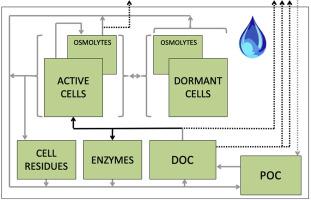Soil Biology and Biochemistry ( IF 9.7 ) Pub Date : 2020-06-01 , DOI: 10.1016/j.soilbio.2020.107871 Albert C. Brangarí , Stefano Manzoni , Johannes Rousk

|
Soils are continuously exposed to cycles of drying and rewetting (D/RW), which drive pronounced fluctuations in soil carbon (C) fluxes. These C dynamics are characterized by a decoupled behavior between microbial biomass synthesis (growth) and CO2 production (respiration). In general, respiration rates peak shortly after RW and subsequently decrease, while the growth peaks lag several hours behind. Despite the significance of these dynamics for the soil C budget and the global C cycle, this feature has so far been overlooked in biogeochemical models and the underlying mechanisms are still unclear. We present a new process-based soil microbial model that incorporates a wide range of physical, chemical and biological mechanisms thought to affect D/RW responses. Results show that the model is able to capture the respiration dynamics in soils exposed to repeated cycles of D/RW, and also to single events in which moisture was kept constant after RW. In addition, the model reproduces, for the first time, the responses of microbial growth to D/RW. We have identified the C accumulation during dry periods, the drought-legacy effect on the synthesis of new biomass, and osmoregulation as the strongest candidate mechanisms to explain these C dynamics. The model outputs are further compared to earlier process-based models, highlighting the advances generated by the new model. This work thus represents a step towards unravelling the microbial responses to drought and rainfall events, with implications for our understanding of C cycle and C sequestration in soils.
中文翻译:

土壤微生物模型,用于分析土壤干燥和再润湿过程中分离的微生物生长和呼吸
土壤连续暴露于干燥和再润湿(D / RW)循环中,这会导致土壤碳(C)通量出现明显波动。这些碳动力学的特征是微生物生物量合成(增长)与CO 2之间的分离行为生产(呼吸)。通常,呼吸速率在RW之后不久达到峰值,然后下降,而生长峰值则落后几个小时。尽管这些动力学对土壤碳收支和全球碳循环具有重要意义,但迄今为止,该特征在生物地球化学模型中仍被忽略,其潜在机制仍不清楚。我们提出了一种新的基于过程的土壤微生物模型,该模型结合了广泛的物理,化学和生物机制,这些机制被认为会影响D / RW反应。结果表明,该模型能够捕获暴露于D / RW重复循环的土壤中的呼吸动力学,以及暴露于RW后水分保持恒定的单个事件。此外,该模型首次再现了微生物生长对D / RW的响应。我们已经确定了干旱时期的碳积累,干旱对新生物质合成的遗留影响以及渗透压调节是解释这些碳动态的最强候选机制。该模型的输出与早期基于过程的模型进行了进一步的比较,突出了新模型所产生的进步。因此,这项工作代表了朝着揭示微生物对干旱和降雨事件的反应迈出的一步,对我们对土壤中碳循环和碳固存的理解具有启示意义。


























 京公网安备 11010802027423号
京公网安备 11010802027423号